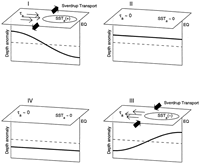
The recharge oscillator theory of J97 is schematically illustrated in Fig. 1. All quantities in the figure are anomalies relative to the climatological mean seasonal cycle. The mean structure involves a thermocline shoaling to the east; westward winds throughout the basin, causing upwelling due to Ekman divergence; and higher SST in the western Pacific warm pool.
FIG. 1. Idealized schematic of the El Niño-La Niña oscillation
(modified from Jin
1997a). All quantities shown are anomalies relative to the climatological
mean. Depth anomaly is relative to the time mean structure along the equator.
Dashed line indicates zero anomaly; shallow anomalies are above the dashed line
and deep anomalies are below the dashed line. Thin arrows and symbol  a
represent the anomalous zonal wind stress; bold thick arrows represent the corresponding
anomalous Sverdrup transports. SSTa is the sea surface temperature
anomaly. Oscillation progresses clockwise around the panels following the roman
numerals; panel I represents El Niño conditions, panel III indicates La
Niña conditions.
a
represent the anomalous zonal wind stress; bold thick arrows represent the corresponding
anomalous Sverdrup transports. SSTa is the sea surface temperature
anomaly. Oscillation progresses clockwise around the panels following the roman
numerals; panel I represents El Niño conditions, panel III indicates La
Niña conditions.
The oscillation proposed by J97 results from phase lags between changes in the zonally averaged main thermocline depth and changes in the eastern Pacific SST, central Pacific zonal wind stress, and zonal thermocline tilt, the latter three being in phase with one another. In this theory, the discharge (recharge) of the warm water to (from) higher latitudes is affected by the meridional transports resulting from the anomalous eastward (westward) zonal winds near the equator. In particular, meridional transports in the ocean interior (i.e., away from the western boundary currents) are close to being in Sverdrup balance with the wind stress curl (Philander 1990). These transports are incompletely balanced by western boundary current transports on interannual time scales (e.g., Springer et al. 1990), which leads to low frequency changes in the WWV near the equator associated with the ENSO cycle.
The transition to El Niño (La Niña) results from the wind-driven upwelling of warmer (colder) waters due to the deeper (shallower)-than-normal main thermocline. Since the climatological thermocline is deeper in the western Pacific than in the eastern, changes in the temperature of upwelled water are smaller in the west than in the east. These E-W contrasts lead to changes in the zonal gradient of SST and in zonal wind stress. The oscillatory nature of ENSO in this scenario results from the disequilibrium between equatorial zonal winds and zonal mean thermocline depth, the latter of which is associated with meridionally converging and diverging Sverdrup transports.
J97 documented aspects of these variations using observations. However, the ocean data available to him was limited to SST and scattered-island sea level measurements. The datasets used in this study are better suited to testing the hypothesized relationships.
Return to previous section or go to next section